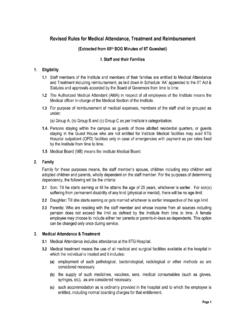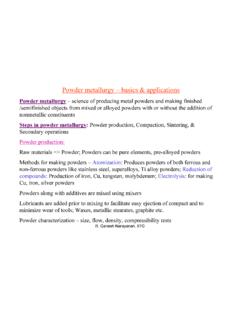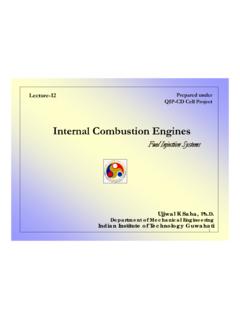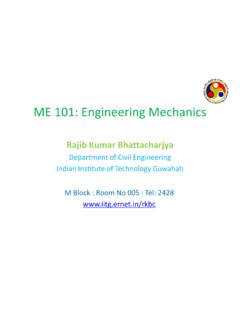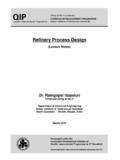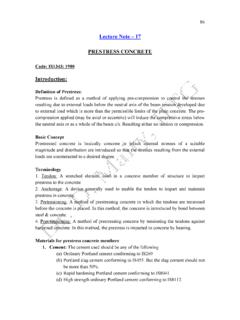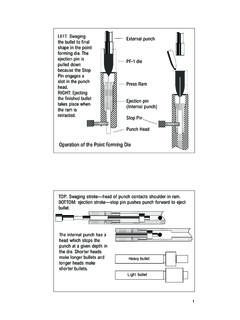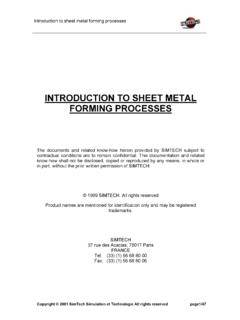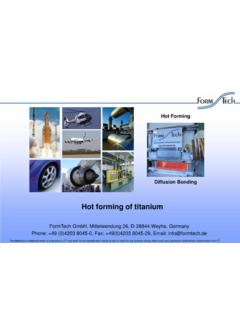Transcription of Metal forming processes - iitg.ac.in
1 Metal forming processes Metal forming : Large set of manufacturing processes in which the material is deformed plastically to take the shape of the die geometry. The tools used for such deformation are called die, punch etc. depending on the type of process. Plastic deformation: Stresses beyond yield strength of the workpiece material is required. Categories: Bulk Metal forming , Sheet Metal forming stretching General classification of Metal forming processes Groover,R. Ganesh Narayanan, Fundamental IITG. of modern manufacturing Materials, processes and systems, 4ed Classification of basic bulk forming processes Forging Wire drawing Extrusion Rolling Bulk forming : It is a severe deformation process resulting in massive shape change.
2 The surface area-to-volume of the work is relatively small. Mostly done in hot working conditions. Rolling: In this process, the workpiece in the form of slab or plate is compressed between two rotating rolls in the thickness direction, so that the thickness is reduced. The rotating rolls draw the slab into the gap and compresses it. The final product is in the form of sheet. Forging: The workpiece is compressed between two dies containing shaped contours. The die shapes are imparted into the final part. Extrusion: In this, the workpiece is compressed or pushed into the die opening to take the shape of the die hole as its cross section. Wire or rod drawing: similar to extrusion, except that the workpiece is pulled through the die opening to take the cross-section.
3 R. Ganesh Narayanan, IITG. Classification of basic sheet forming processes Bending Deep drawing shearing Sheet forming : Sheet Metal forming involves forming and cutting operations performed on Metal sheets, strips, and coils. The surface area-to-volume ratio of the starting Metal is relatively high. Tools include punch, die that are used to deform the sheets. Bending: In this, the sheet material is strained by punch to give a bend shape (angle shape). usually in a straight axis. Deep (or cup) drawing: In this operation, forming of a flat Metal sheet into a hollow or concave shape like a cup, is performed by stretching the Metal in some regions. A blank-holder is used to clamp the blank on the die, while the punch pushes into the sheet Metal .
4 The sheet is drawn into the die hole taking the shape of the cavity. Shearing: This is nothing but cutting of sheets by shearing action. R. Ganesh Narayanan, IITG. Cold working, warm working, hot working Cold working: Generally done at room temperature or slightly above RT. Advantages compared to hot forming : (1) closer tolerances can be achieved; (2) good surface finish; (3) because of strain hardening, higher strength and hardness is seen in part; (4) grain flow during deformation provides the opportunity for desirable directional properties; (5) since no heating of the work is involved, furnace, fuel, electricity costs are minimized, (6). Machining requirements are minimum resulting in possibility of near net shaped forming .
5 Disadvantages: (1) higher forces and power are required; (2) strain hardening of the work Metal limit the amount of forming that can be done, (3) sometimes cold forming - annealing-cold forming cycle should be followed, (4) the work piece is not ductile enough to be cold worked. Warm working: In this case, forming is performed at temperatures just above room temperature but below the recrystallization temperature. The working temperature is taken to be Tm where Tm is the melting point of the workpiece. Advantages: (1) enhanced plastic deformation properties, (2) lower forces required, (3). intricate work geometries possible, (4) annealing stages can be reduced. R. Ganesh Narayanan, IITG. Hot working: Involves deformation above recrystallization temperature, between to Advantages: (1) significant plastic deformation can be given to the sample, (2) significant change in workpiece shape, (3) lower forces are required, (4).
6 Materials with premature failure can be hot formed, (5) absence of strengthening due to work hardening. Disadvantages: (1) shorter tool life, (2) poor surface finish, (3) lower dimensional accuracy, (4) sample surface oxidation R. Ganesh Narayanan, IITG. Bulk forming processes Forging It is a deformation process in which the work piece is compressed between two dies, using either impact load or hydraulic load (or gradual load) to deform it. It is used to make a variety of high-strength components for automotive, aerospace, and other applications. The components include engine crankshafts, connecting rods, gears, aircraft structural components, jet engine turbine parts etc. Category based on temperature : cold, warm, hot forging Category based on presses: impact load => forging hammer; gradual pressure => forging press Category based on type of forming : Open die forging, impression die forging, flashless forging In open die forging, the work piece is compressed between two flat platens or dies, thus allowing the Metal to flow without any restriction in the sideward direction relative to the die surfaces.
7 R. Ganesh Narayanan, IITG. Open die forging Groover, Fundamental of modern manufacturing Materials, processes and systems, 4ed impression die forging flashless forging In impression die forging, the die surfaces contain a shape that is given to the work piece during compression, thus restricting the Metal flow significantly. There is some extra deformed material outside the die impression which is called as flash. This will be trimmed off later. In flashless forging, the work piece is fully restricted within the die and no flash is produced. The amount of initial work piece used must be controlled accurately so that it matches the volume of the die cavity. R. Ganesh Narayanan, IITG. Open die forging A simplest example of open die forging is compression of billet between two flat die halves which is like compression test.
8 This also known as upsetting or upset forging. Basically height decreases and diameter increases. Under ideal conditions, where there is no friction between the billet and die surfaces, homogeneous deformation occurs. In this, the diameter increases uniformly throughout its height. In ideal condition, = ln (ho/h). h will be equal to hf at the end of compression, will be maximum for the whole forming . Also F = f A is used to find the force required for forging, where f is the flow stress corresponding to at that stage of forming . Start of compression Partial compression Completed compression R. Ganesh Narayanan, IITG. Groover, Fundamental of modern manufacturing Materials, processes and systems, 4ed In actual forging operation, the deformation will not be homogeneous as bulging occurs because of the presence of friction at the die-billet interface.
9 This friction opposes the movement of billet at the surface. This is called barreling effect. The barreling effect will be significant as the diameter-to-height (D/h) ratio of the workpart increases, due to the greater contact area at the billet die interface. Temperature will also affect the barreling phenomenon. Start of Partial Completed compression compression compression In actual forging, the accurate force evaluation is done by using, F = Kf f A by considering the effect of friction and D/h ratio. Here, D. K f 1 . h Where Kf = forging shape factor, = coefficient of friction, D = work piece diameter, h = work piece height R. Ganesh Narayanan, IITG. Typical load-stroke curve Effect of D/h ratio on load: in open die forging Compression Load 2 > 1.
10 2. 1. 0. Effect of h/D ratio on barreling: D/h Long cylinder: h/D >2 Cylinder having h/D < 2 Frictionless compression R. Ganesh with Narayanan, IITG. friction Closed die forging Closed die forging called as impression die forging is performed in dies which has the impression that will be imparted to the work piece through forming . In the intermediate stage, the initial billet deforms partially giving a bulged shape. During the die full closure, impression is fully filled with deformed billet and further moves out of the impression to form flash. In multi stage operation, separate die cavities are required for shape change. In the initial stages, uniform distribution of properties and microstructure are seen.

